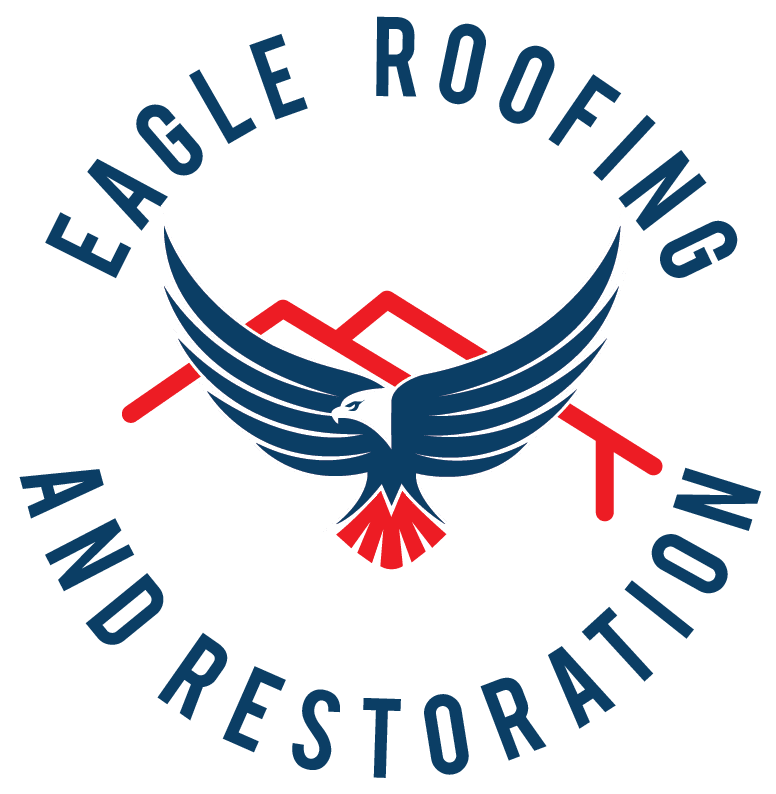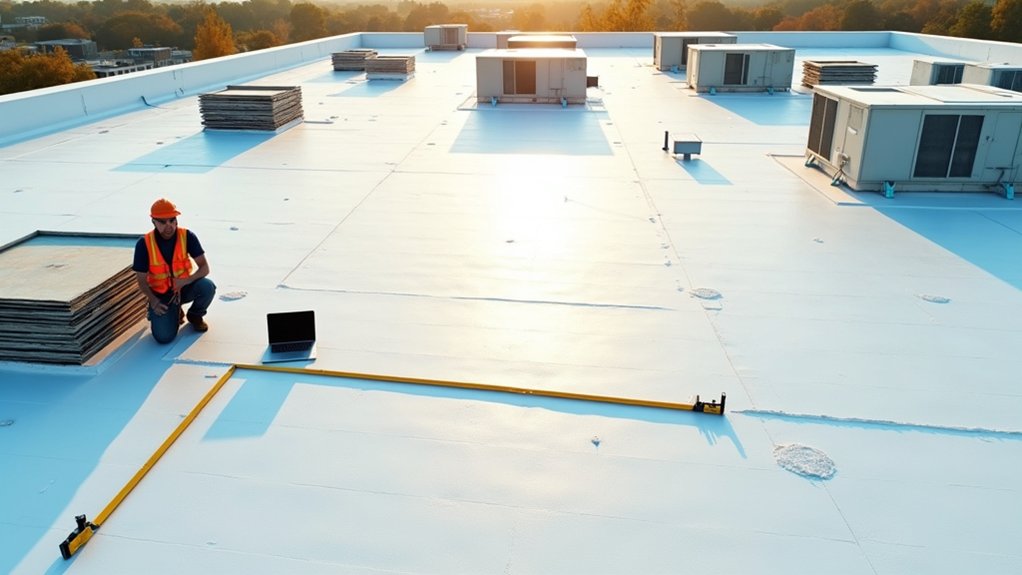To calculate your commercial roofing costs, expect to spend between $3.50 to $15.00 per square foot, with total project expenses varying based on five essential factors. You’ll need to measure your roof’s square footage, select appropriate materials, factor in labor rates of $40-$80 per worker, account for regional price variations of 10-30%, and add a 10-15% contingency buffer. Understanding these key components will help you develop an accurate budget for your roofing project.
Measure Your Roof’s Total Square Footage
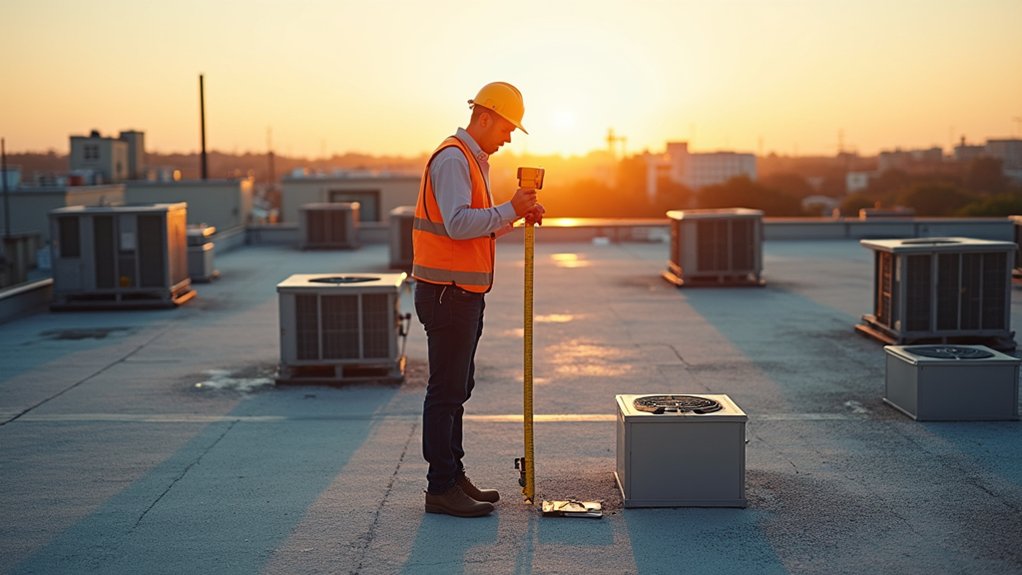
Before calculating commercial roofing costs, you’ll need accurate measurements of your roof’s total square footage. Begin by measuring the length and width of each roof section from the ground, then multiply these dimensions for the base square footage. Factor in your roof pitch assessment, as steeper angles require additional material to cover the true surface area.
When measuring, account for roof accessibility considerations that could affect the precision of your measurements. Use aerial imagery or blueprints if direct access is limited. Don’t forget to include overhangs and factor in any protrusions like chimneys, vents, or HVAC units. For complex roof designs with multiple levels or sections, measure each area separately and add them together for your total square footage. Double-check all measurements to guarantee accurate cost estimates.
Select Your Roofing Material and System Type
Selecting the right commercial roofing material and system directly impacts your project’s longevity and budget. You’ll need to evaluate several options, including TPO, EPDM, modified bitumen, metal roofing, and built-up roofing (BUR) systems. Each material offers distinct advantages with respect to durability, energy efficiency, and cost-effectiveness.
Consider your building’s specific requirements when exploring roof coating options. White reflective coatings can reduce energy costs, while silicone-based solutions offer superior waterproofing. Don’t overlook roofing warranty considerations, as different materials and installation methods carry varying coverage terms. Some manufacturers offer warranties ranging from 10 to 30 years, depending on the system type and installation quality. Your choice should balance initial costs with long-term performance, maintenance requirements, and climate conditions in your area.
Factor in Labor and Installation Costs
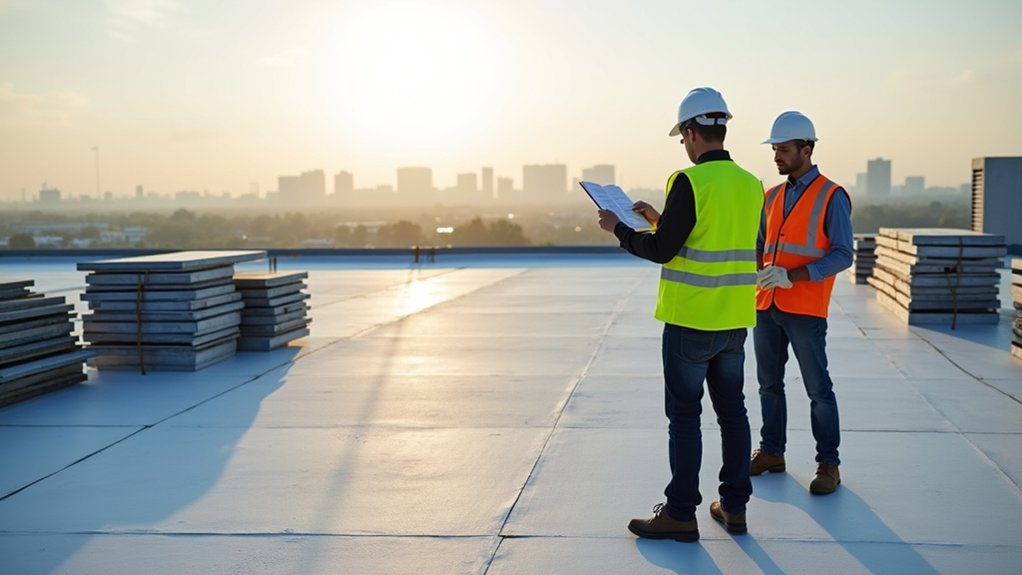
While material costs form a significant portion of your commercial roofing budget, labor and installation expenses often account for 40-60% of the total project cost. You’ll need to factor in equipment rental costs like cranes, lifts, and safety gear, along with the specialized labor required for proper installation.
Consider roof accessibility and complexity when calculating labor costs, as difficult-to-reach areas or unusual configurations will increase working hours and equipment needs.
- Hourly rates for skilled roofing crews typically range from $40-$80 per worker
- Equipment rental fees can add $500-$2,500 per day depending on requirements
- Complex installations may require additional safety measures and specialized tools
- Location and seasonal factors affect labor rates and project timeline
Remember to obtain detailed labor estimates from multiple contractors to guarantee competitive pricing while maintaining quality workmanship.
Account for Regional Price Variations
Regional differences across the United States can greatly impact your commercial roofing costs, with variations of 10-30% between major metropolitan areas. You’ll find higher prices in coastal regions like New York and California due to stricter building regulations and higher labor costs.
When calculating regional costs, examine weather patterns that affect material choices and installation timing. Areas with heavy snowfall require stronger structural support, while hurricane-prone regions need wind-resistant materials. You’ll need to scrutinize local building codes that mandate specific requirements for insulation values, wind uplift resistance, and fire ratings.
To get accurate estimates, consult local contractors who understand your area’s unique challenges. They can recommend appropriate materials and installation methods based on regional climate conditions and regulatory requirements, helping you avoid costly modifications later.
Calculate Additional Expenses and Contingencies
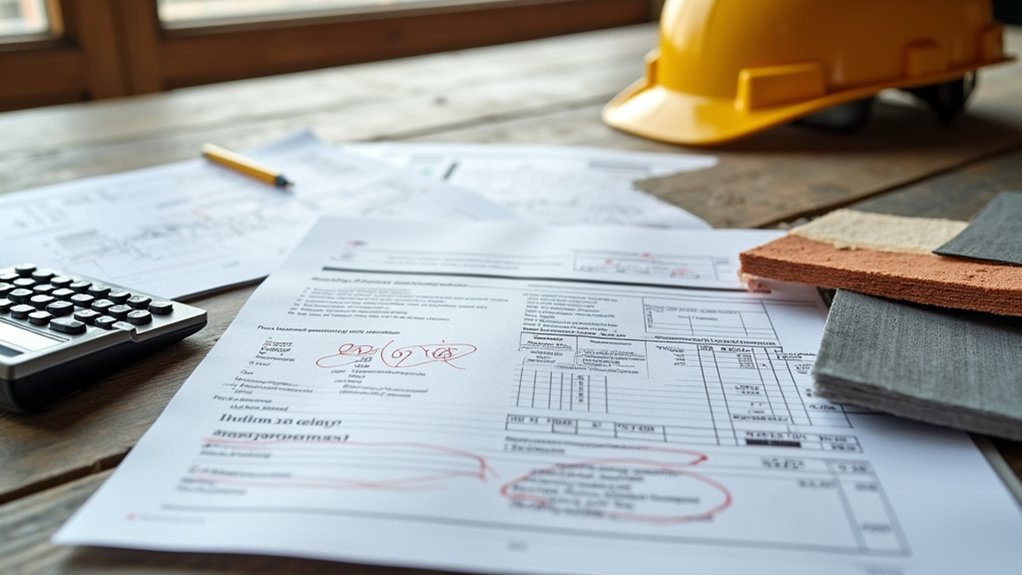
Beyond the base costs of materials and labor, you’ll need to account for several critical contingencies that can impact your commercial roofing budget. Project management expenses and unforeseen circumstances can substantially affect your final costs, making it essential to plan ahead.
When calculating additional expenses, consider these key factors:
- Permits and inspection fees, which vary by municipality and project scope
- Insurance coverage adjustments and bonding requirements specific to roofing projects
- Emergency repairs or structural issues discovered during installation
- Weather-related delays that can extend project timelines and increase labor costs
To protect your investment, add a 10-15% contingency buffer to your budget. This margin helps absorb unexpected costs while ensuring your project stays financially viable through completion.
Frequently Asked Questions
How Long Does a Commercial Roof Installation Typically Take to Complete?
Your commercial roof installation timeline typically ranges from 2-6 weeks, depending on several key factors. The construction timeline varies based on your building’s size, roof complexity, and weather conditions. You’ll find that a 10,000-square-foot roof might take 2-3 weeks, while larger projects can extend to 6 weeks or more. Material choices and crew size will also impact how quickly you can complete the installation.
What Warranties Are Available for Commercial Roofing Systems?
You’ll typically find two main types of commercial roofing warranties: roof material warranties and roof installation warranties. Material warranties, provided by manufacturers, cover defects in the roofing products and usually last 10-30 years depending on the system. Installation warranties, offered by your contractor, protect against workmanship errors and typically range from 2-10 years. It’s important to read the fine print, as coverage limits and maintenance requirements differ considerably between warranty types.
Can a New Commercial Roof Be Installed Over Existing Roofing Materials?
Yes, you can install a new commercial roof over existing materials, but you’ll need a thorough roof integrity assessment first. This evaluation checks structural support capacity and moisture levels. Material compatibility between old and new roofing is pivotal not all systems work together. While overlaying can save money on tear-off costs, it’s not always the best solution. Building codes typically allow only two layers of roofing before requiring complete removal.
How Often Should Commercial Roofs Undergo Professional Maintenance and Inspection?
You should schedule professional commercial roof inspections at least twice per year typically in spring and fall. Regular inspections help identify potential issues before they become major problems. It is crucial to have your roof checked after severe weather events too. By maintaining a consistent inspection schedule and making timely repairs, you’ll extend your roof’s lifespan and prevent costly damage. Most warranties also require documented maintenance to remain valid.
What Building Permits Are Required for Commercial Roof Replacement Projects?
You’ll need to obtain several permits before starting a commercial roof replacement. First, secure a general building permit through your local municipality’s approval process. You’ll also need to meet specific building code requirements, which often include structural, fire safety, and energy compliance permits. Don’t forget to check if you need special permits for historic buildings or zoning restrictions. Contact your local building department early, as permit processing can take several weeks.
